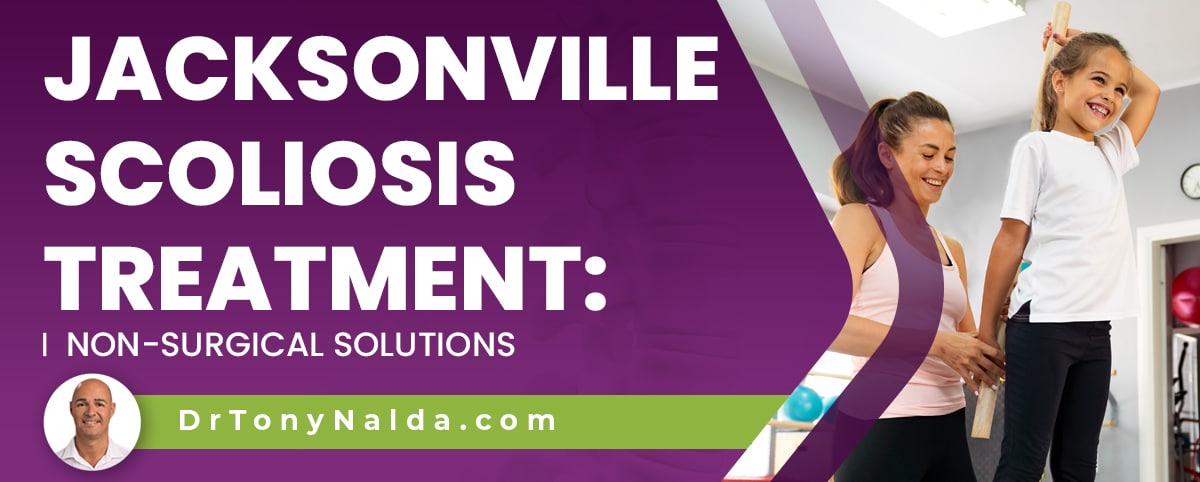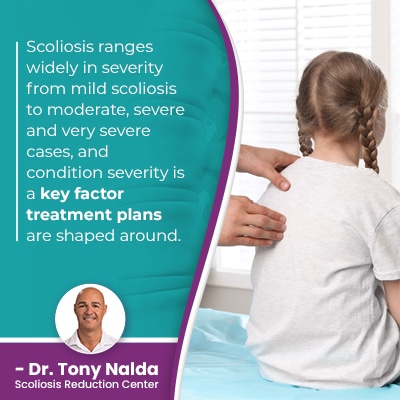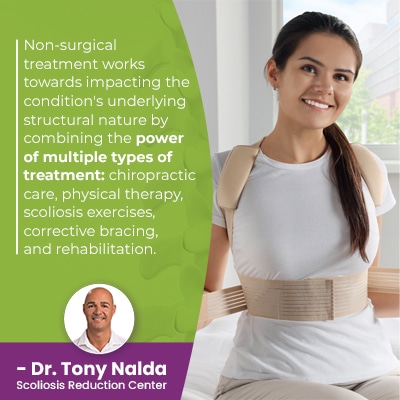Jacksonville Scoliosis Treatment: Non-Surgical Solutions

When it comes to treating scoliosis, as a progressive condition, when treatment is started can be a key factor, and different treatment approaches shape long-term spinal health differently; it's important that patients make informed treatment choices.
Jacksonville residents can access Orlando, Florida's non-surgical treatment center, the Scoliosis Reduction Center® with a 2.5-hour flight; Dr. Tony Nalda has earned the reputation of a renowned scoliosis chiropractor with an innovative non-surgical treatment approach that can be worth traveling for.
One of the challenges to treating scoliosis is its progressive nature, so let's start with what triggers progression, and how treatment can help.
Table of Contents
Scoliosis is Progressive
Scoliosis is a progressive condition; its nature is to get more severe over time.
We don't know what causes most cases of scoliosis to develop initially, but we know it's growth that makes it progress, so the more growth a child has to go through means the more potential progression they can face; adolescents are the most at risk for fast progression due to the rapid and unpredictable growth spurts of puberty.
As scoliosis causes the spine to bend unnaturally to the side and twist, progression means the size of the unnatural spinal curve is increasing, as are the condition's uneven forces, and their effects.
Scoliosis progressing makes it more complex to treat; the spine gets increasingly rigid and less responsive to treatment, and some patients find performing therapeutic exercises difficult, and core strengthening is an important part of non-surgical scoliosis treatment.
 Scoliosis ranges widely in severity from mild scoliosis to moderate, severe and very severe cases, and condition severity is a key factor treatment plans are shaped around.
Scoliosis ranges widely in severity from mild scoliosis to moderate, severe and very severe cases, and condition severity is a key factor treatment plans are shaped around.
As scoliosis progresses, condition effects become more overt, and in children, this means postural changes.
Common Effects of Childhood Scoliosis
The most common effects of childhood scoliosis involve postural changes caused by the condition's uneven forces disrupting the body's overall symmetry.
In many cases, the earliest signs of childhood scoliosis are uneven shoulders and uneven hips.
Additional postural changes, and scoliosis symptoms, to expect in children can include:
- Uneven shoulder blades
- The development of a rib cage arch
- Arms and legs that hang at different lengths
- Changes to balance, coordination, and gait
- Excessive tiredness
As the body's center of gravity shifts, changes to movement are common, and particularly when severe, it can be difficult to counteract the uneconomical gait; excessive tiredness can be a symptom of scoliosis.
When it comes to pain, this is more closely associated with adult scoliosis.
Common Effects of Adult Scoliosis
Scoliosis becomes a compressive condition once skeletal maturity has been reached, and this is when the condition commonly becomes painful.
Pain isn't considered a common symptom of childhood scoliosis because the constant lengthening motion of growth counteracts the compressive force of the unnatural spinal curve, and compression affects the spine and its surrounding muscles and nerves, and its effects can be felt throughout the body.
Compression is uneven pressure and is the main cause of condition-related pain including back pain, muscle pain, and nerve pain; adult scoliosis treatment has to include pain relief as a focus as pain can range from mild and intermittent to chronic pain that's debilitating.
The focus of scoliosis treatment for all ages is to improve every patient's physical and mental well being, for a better quality of life.
The lack of pain in childhood scoliosis is a challenge to early detection, and pain that radiates into the extremities is the main symptom of adult scoliosis that leads to a diagnosis and treatment.
Adults also experience a prominent lean to one side and postural changes that are most noticeable when in a forward-bend position.
The two most common types of scoliosis to affect adults are idiopathic scoliosis and degenerative scoliosis.
Degenerative Scoliosis
As progression is triggered by growth, the risk of rapid progression is not as high once skeletal maturity has been reached in adulthood, but once spinal degeneration becomes a factor, progression can increase as the spine becomes increasingly unbalanced and unstable.
Natural age-related spinal degeneration, and the cumulative effect of certain lifestyle factors, cause degenerative scoliosis in adults, most often females over the age of 50; degenerative changes are more common and severe in females due to the changes in bone density and hormones associated with menopause.
The spine of an adult is more vulnerable to compression and degeneration, and this makes it more rigid, unstable, and difficult to treat.
Why Treat Scoliosis Non-Surgically?
Jacksonville fl patients looking for scoliosis treatment can access Dr. Tony's non-surgical treatment center with less than a 2.5-hour flight, and once a patient of the Center, accessing multiple facets of treatment under one roof is convenient and effective.
 While traditional scoliosis treatment responds with spinal fusion surgery for severe, very severe, and atypical cases of scoliosis, the reality is that many cases don't need surgical intervention, particularly with early detection and intervention.
While traditional scoliosis treatment responds with spinal fusion surgery for severe, very severe, and atypical cases of scoliosis, the reality is that many cases don't need surgical intervention, particularly with early detection and intervention.
Conservative non-surgical treatment responds to a diagnosis proactively, by starting treatment as close to the time of diagnosis as possible, while traditional treatment often recommends watching and waiting while conditions are mild, which is when they are the most treatable.
Traditional treatment doesn't have a strategy for addressing scoliosis while mild, so recommends observation with period check ups for progression, but as growth spurts trigger progression, if a significant growth spurt occurs, rapid progression can quickly make the condition more complex to treat.
When/if conditions become severe and/or in atypical cases of scoliosis, spinal surgery can be recommended, and this is invasive, costly, and risky.
Non-surgical treatment works towards impacting the condition's underlying structural nature by combining the power of multiple types of treatment: chiropractic care, physical therapy, scoliosis exercises, corrective bracing, and rehabilitation.
Spinal Flexibility and Function
One of the most common side effects of living with a fused spine is a noticeable loss in spinal flexibility and range of motion.
Spinal fusion involves fusing the curve's most-tilted vertebrae into one solid bone to prevent progression, but this immoveable portion of the spine is contrary to the spine's natural movement-based design.
A spine that's rigid is also one that's more painful, weaker, and vulnerable to injury.
A conservative approach preserves the spine's natural strength and function for the best long-term spinal health and quality of life.
While some fused spines maintain enough flexibility above and below the fused portion, others experience a noticeable difference that can lead to activity restrictions.
A spine that has its healthy curves restored is one that's going to function optimally, and fusing the spine isn't always the best choice for overall spinal health, and once a spine is fused, it's fused for life.
So a spine that has a curvature reduction worked towards through chiropractic care, and surrounding muscles that are strengthened and balanced through physical therapy and scoliosis exercises is a spine that has as much of its natural curves, strength, and function as possible preserved.
Conclusion
If willing to take a 2.5-hour flight to Orlando, Florida's Scoliosis Reduction Center®, Jacksonville scoliosis patients can become patients of a scoliosis chiropractor known for his innovative and effective approach to non-surgical scoliosis treatment.
When Dr. Tony is involved, Jacksonville scoliosis treatment can include fully understanding scoliosis, premier scoliosis care, specialized attention through an individualized approach, immediate help through a proactive treatment response, and effective non-surgical scoliosis treatment.
An unnatural spinal curvature means spinal alignment is disrupted, and this means a number of uneven forces are being introduced to the spine, its surroundings, and the entire body.
The most common type of scoliosis is idiopathic scoliosis, and atypical condition types are associated with known causes: neuromuscular scoliosis, degenerative scoliosis, and congenital scoliosis.
While adolescents are most commonly diagnosed, the actual rate of scoliosis increases among the aging population due to age-related spinal degeneration and the development of degenerative scoliosis.
An initial consultation with a patient is about education; I want to ensure every patient is aware of all treatment options available to them so they can make an informed choice.
The benefit of a conservative non-surgical treatment approach over scoliosis surgery is that it works towards improving overall spine health and strength, improve mobility and spinal flexibility, manage progression, and reduce pain and curve sizes.
Reducing pain for the long term means addressing its underlying cause: the condition itself. I use a number of chiropractic techniques, manual adjustments, and spinal manipulation to work towards repositioning the most-tilted vertebrae at the apex of the abnormal curvature.
Scoliosis physical therapy can support structural changes (curve reductions) by working towards improving the spine's surrounding muscles balance and strength for optimal spinal support/stability.
There are never treatment guarantees, but the Center's results speak for themselves.
Dr. Tony Nalda
DOCTOR OF CHIROPRACTIC
After receiving an undergraduate degree in psychology and his Doctorate of Chiropractic from Life University, Dr. Nalda settled in Celebration, Florida and proceeded to build one of Central Florida’s most successful chiropractic clinics.
His experience with patients suffering from scoliosis, and the confusion and frustration they faced, led him to seek a specialty in scoliosis care. In 2006 he completed his Intensive Care Certification from CLEAR Institute, a leading scoliosis educational and certification center.
About Dr. Tony Nalda
 Ready to explore scoliosis treatment? Contact Us Now
Ready to explore scoliosis treatment? Contact Us Now





